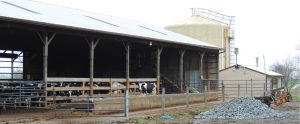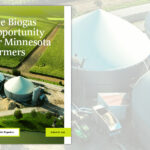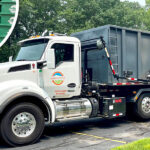BioCycle June 2015
Albany County, New York: Moving Forward With Codigestion
The Albany County Sewer District (ACSD) ran a pilot in 2012 at its South Wastewater Treatment Plant to investigate codigestion of mixed food waste streams to determine biogas yields. “The project successfully demonstrated higher biogas/energy yields when sewage sludge is codigested with high energy waste, such as residential food waste, bakery waste and fats oils and grease (FOG),” explains Rich Lyons, executive director of ACSD. “The highest gas yields were a ratio of 5:4:1 of sewage sludge: bakery: FOG.” The District then conducted a codigestion feasibility study that was finalized in November 2013 and presented to the Albany County Board of Commissioners, Legislature and the County Executive’s office in January 2014. “The report concluded the project is feasible from a technical and regulatory perspective,” adds Lyons. “It provides environmental, economic and community benefits. Projected digester feedstocks include 9.8 dry tons/day (tpd) of sewage sludge, 0.2 dry tpd of FOG and 6.8 dry tpd of food waste. The projected combined heat and power is 1.0 MW. We estimate that there are 95 tpd available within a 60-mile radius of the South Plant, which is located at the crossroads of three major interstates.” The WWTP is permitted for 29 million gallons/day (mgd), with 45 mgd peak flow. Currently, ACSD is evaluating options for financing a codigestion project.
Brussels, Belgium: EU Biogas Group Pushes For Digestate As Fertilizer
The European Biogas Association (EBA) is lobbying the European Commission to revise its Fertilizer Regulation to recognize digestate as an organic fertilizer. Inclusion of the by-product of anaerobic digestion as fertilizer, EBA argues, would boost nutrient recycling in the framework of the European Union’s (EU) wider “circular economy” strategy, while improving the economics of anaerobic digestion. The rules would “help create markets for the alternative to mineral fertilizers produced in very energy-intensive processes,” said Nicolas de la Vega, EBA’s policy advisor. Furthermore, being able to sell digestate would allow farmers to reduce waste by recycling all the material that goes into biogas production, according to the industry.
The current EU regulation only recognizes mineral fertilizers. And four years’ worth of work on a revision to include organic fertilizers such as digestate and compost was halted when the review process was taken off the European Commission’s annual work schedule. A background paper identifying measures that could be taken under the new circular economy package included a “possible revision” of the fertilizer law.
Rosemont, Illinois: Dairy Sustainability Awards
The Innovation Center for U.S. Dairy® announced the winners of its fourth annual U.S. Dairy Sustainability Awards on May 7, 2015. The program recognizes outstanding dairy farms, businesses and partnerships for “practices large and small that not only focus on the environment, but add up to promote the health and well-being of consumers, communities, cows, employees, the planet and business.” In announcing the awards, Barbara O’Brien, president of the Innovation Center, said “each winner has a unique commitment to sustainability that has strengthened their connections with their communities, ensured the stability of the waterways and wildlife surrounding their properties, and blazed new trails for other dairy farms and businesses to follow.” Winners are selected based on results as measured by economic, environmental and community impact, also known as triple-bottom-line success, as well as the potential for adoption by others, demonstrated learning, innovation, improvement and scalability.
The Award winner for Outstanding Achievement in Resource Stewardship is Freund’s Farm (East Canaan, CT), which has created a successful side business selling CowPots®, biodegradable gardening containers made of composted manure from the farm’s herd of 275 dairy cows. A solar panel system produces 100 percent of its electricity needs. One of the award winners for Outstanding Dairy Farm Sustainability is Oregon Dairy Farm (Lititz, PA), operated by the Hurst family (see “Tapping Digesters, Composting To Manage Manure And Food Waste,” May 2011). Oregon Dairy composts food waste along with cow manure, runs solar panels on its grocery store roof to provide 10 percent of the store’s electricity needs, and operates an anaerobic digester, with biogas used to make electricity and heat for hot water.
The Outstanding Achievement in Community Partnerships award was given to HP Hood LLC and CleanWorld (Sacramento, CA) for finding a way to collect and combine HP Hood’s 35 tons/week of organic residuals with food waste from dozens of local restaurants and retailers. Diverted organics are processed in CleanWorld’s biodigester. Biogas from the digester is conditioned and compressed into renewable fuel for public and private fleets of trucks. www.DairyGood.org.
North Fork, California: Forest-Sourced Biomass Gasification
The North Fork Community Power project was awarded a $4.9 million grant from the California Energy Commission (CEC) in April to help finance construction of a biomass gasification plant that will utilize local forest biomass sustainably sourced from restoration and fuel reduction activities on local forest lands, including the Sierra National Forest. The biomass will be used to make electricity, heat and biochar. According to the project developers — a joint venture between Phoenix Energy and the North Fork Community Development Council (Northfork CDC) — North Fork Community Power will be one of the first projects to use forest-based fuel under California’s SB 1122 bioenergy law. The rule requires 250 megawatts (MW) of electricity to be generated from organic waste; 50 MW of the 250 MW is from forestry debris from high wildfire hazard zones.
Phoenix Energy is an independent power producer that operates a network of small distributed generation biomass gasification plants in partnership with businesses and communities. By focusing on small plants in a 1 to 3 MW range, the company strives to keep electricity, heat and fuel local to the plant where the value of energy is highest and transportation costs are lower.
“In the North Fork community, a sawmill was the main employer for years, and local jobs evaporated when it closed down in the 1990s,” says Phoenix Energy CEO, Gregory Stangl. “This facility will not only make an impact on reducing fire danger and stopping wasteful ‘pile and burn’ disposal of excess forest material, but will bring back permanent jobs to a town where the forest economy used to provide them.” The North Fork CDC is a nonprofit that was established to encourage economic development after the closure of the mill. “We are delighted to be able to combine environmental stewardship with job creation and sustainable energy production for our community,” adds Dan Rosenberg, North Fork CDC President. “We are hoping that our plant will serve as a model for other forested communities while having a positive environmental impact and improving the fire safety of our community.” The plant will be built in phases with an initial 1 MW financed mainly by the CEC grant and private and community investors. Power will be sold to Pacific Gas & Electric under the SB1122 law.














